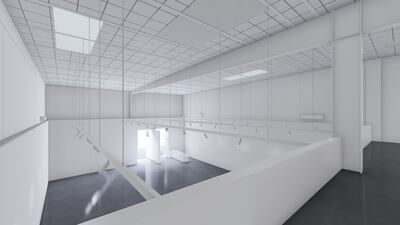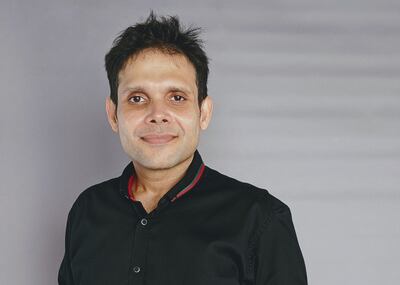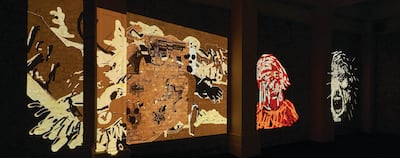Alserkal Avenue is welcoming a new gallery to its roster: Mumbai's Volte Art Projects.
Starting in September, the gallery which shows a mix of international artists such as Wim Delvoye, James Turrell, Francesco Clemente and William Kentridge, as well as regional artists like Nalini Malani and Ranbir Kaleka, will be staging around three exhibitions a year.
“I saw the potential of the region and how great Alserkal Avenue is as a cultural district,” Tushar Jiwarajka, who founded the gallery in 2009, tells The National. “You can't find spaces like what Alserkal offers you in India – 8,000-square-foot, high ceilings and open warehouse. And the fact that Alserkal is not just your landlord, but they actively support you as your partner is really exciting.”

The gallerist visited Dubai a few years ago for a friend’s birthday and decided to move here with his family.
“I realised Dubai’s not all malls and golden Lamborghinis,” he says.
He has now lived in the UAE for two years and in September will reopen Volte here. The gallery will occupy the space on the Avenue between 1x1 Art Gallery and Ayyam Gallery, which was formerly used as storage spaces for the latter.
Since being established in Mumbai, Volte Art Projects has followed an unconventional trajectory. Originally, Jiwarajka says, he planned to create something akin to the Institute of Contemporary Arts in London, with social spaces alongside the art.
The operation’s name referred to Cabaret Voltaire, the famous nightclub and performance venue that was set up by Dada artists in Zurich in 1916 for category-dismissing performances and a not insignificant level of revelry. At Volte, Jiwarajka installed a bookshop and cafe and used the gallery to show the work of young, experimental artists.
But it soon became clear, he says, that the business model didn’t work. He found himself running two businesses simultaneously, neither of which supported the other. By the end of the first year, he was already thinking of how he might switch tack.
Jiwarajka then had a stroke of luck that in retrospect seems incredible.
A friend from New York had sent him a videocassette from the documentary series Art21, which focuses in depth on the work of major contemporary artists. Jiwarajka was sitting alone in his gallery, late on a Saturday night, watching an episode on the South African William Kentridge. The celebrated artist, who has been decorated many times over, takes stock of the country’s history through his charcoal drawings, animations and sculptures.
Jiwarajka heard the doorbell ring, but, engrossed in the documentary, didn’t look up. Kentridge had himself walked in.

“After a few minutes, I realised who it was,” recalls Jiwarajka. “I knew his work, but even just an hour earlier I wouldn’t have known what he looked like. I just turned around the laptop and showed him what I was watching.
“He was also completely taken aback. It was his first time ever in India, and he happened to be staying in a hotel close by to the gallery. He had said to his wife, 'Let's go up and see this gallery, it's open'. She asked, 'What gallery is going to be open late on Saturday night?' And he said, 'Well, if it's closed, we'll come back down'.”
With admirable chutzpah and a little naivety, Jiwarajka – at that point the proprietor of a one-year-old gallery – made a play to show Kentridge. The elder artist, intrigued by the possibility of exhibiting his work internationally beyond Europe and America, said yes.
Jiwarajka mounted a solo show of Kentridge a few years later, and then exhibited his work in conjunction with Malani, a pioneer of video art in India.
Not all the other artists on his roster fell into his lap in such an easy manner, but Jiwarajka had seen his opportunity.
“From that point, I decided that I was going to track down and find all my favourite artists and offer them the chance to show in this part of the world,” he recalls.
He has now staged shows with major international artists, and has supported projects with others, such as Malani’s animation chamber at the Whitechapel Gallery in London, Can You Hear Me? (2020–21), and Antony Gormley’s forthcoming show in India, which will inaugurate the Kiran Nadar Museum of Art & Cultural Center when it opens in two years.

And in 2013, he departed from a regular gallery programme altogether, and devoted himself to projects and dealing on the secondary market, which will continue in Dubai.
Volte’s programme in Alserkal Avenue will likewise eschew the typical monthly schedule of gallery exhibitions, opting for a reduced amount – around three per year – with higher impact. He aims to bring blockbuster-quality shows, with both established names and emerging artists, to the new Dubai digs.
“We can bring in major artists who people want to see,” he says. “I found, in the couple of years that I've been in Dubai, that people are really interested, and there is a market. People are hungry to understand and enjoy and be educated.”
The first show, opening before Expo 2020 Dubai in September, will look at the intersection of art, nature, and technology, with artists from Europe, South Africa, India and the US.
Like many businesses, Jiwarajka sees the UAE as a hub between Europe, the Middle East and South Asia, and a number of his existing collectors already live in Dubai. He is also banking that the current investment in art and expansion of the UAE art scene will help him expand his audience in terms of visitor figures.
“There isn't a gallery-going culture in India,” he says. “Even though people are otherwise very culturally engaged, in things like theatre and film and music, art somehow has been a little more elitist.”




